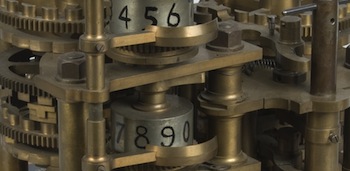Stephanie Dick

Menu:
curriculum vitae

fragment of Charles Babbage's first difference engine. photo courtesy of the Collection of Historical Scientific Instruments.
Selected Publications:
"Of Models and Machines" in Isis Vol. 106, No. 3 (September 2016): 623 - 634.
"Computer Science" in A Companion to the History of American Science (Blackwell Publishing, forthcoming May 2015).
"Machines Who Write" in IEEE Annals for the History of Computing Vol. 35, No. 2 (April-June 2013), pp. 85 - 87.
"AfterMath: The Work of Proof in the Age of Human-Machine Collaboration" in Isis Vol. 102, No. 3 (September, 2011): 494-505.
Upcoming Talks:
September 2018: Early Career Plenary Lecture on the History of Mathematics. European Society for the History of Science Annual Meeting. London, UK.
April 2018: After Math: Reasoning, Computing, and Proof in the Postwar United States. Johns Hopkins Department of History of Science and Technology Colloquium Series. Baltimore, MA.
April 2018: “Making Up Minds: Thinking With, About, and For Humans”. Automatons: From Ovid to AI, Public Lecture Series at the University of King’s College. Halifax, NS.
March 2018: "Colleagues, Assistants, and Servants: Mathematical Visions of Early Computers." Programming Languages Research Group, University of Pennsylvania, PA.
February 2018: "The Automation of Proof." “Theory Group” Seminar Series. Department of Computer Science, University of Pennsylvania. Philadelphia, PA."
Histories of the Future
In February 2015, I attended a Princeton University Workshop in the History of Science that explored Histories of the Future. The contributors produced a series of short articles. My contribution focused on "The Future of Thinking: Computers and Minds in mid-Twentieth Century Imaginations".
Current Research Projects
After Math: Reasoning, Proving, and Computing in the Postwar United States
My first book project is about automation. I am interested in how modern digital computers have been made to participate in endeavors that were once considered uniquely human. In particular, this project explores efforts to automate the production of mathematical proof, long considered to be an exclusive and exemplary feat of human reasoning. Nascent computing technologies were introduced to mathematics during the second half of the twentieth century, and with them came fundamental questions. People reflected anew about the character of human mathematical faculties, like intuition and reasoning, and whether computers could be made to possess them. They reevaluated what kind of demonstrations mathematical proofs ought to be and whether or not algorithmic computation could produce them. They looked for new and unconventional methods of proof that computers might enable and asked after their consequences for mathematical knowledge. Across the United States, different communities---constituted variously of mathematicians, engineers, philosophers, physicists, logicians, psychologists, and others---formulated diverging visions of reasoning, proving, and computing. In the book, I track how they built those perspectives into the mathematical software they developed. By the turn of the twenty-first century, their efforts had produced new forms, both social and technical, of proof.
Doing Data: Implementing our Digital World
My second project is a history of computer memory. In it, I explore the development of memory management strategies, and in particular what are called “data structures,” like binary trees, arrays, linked lists, and so on. Data structures are what they sound like---ways of organizing information in computer memory. On the one hand data structures are profoundly material, to be found in the configuration of bits and bytes of computer memory. But they are also abstract objects that computer science theorists develop, formalize, and prove theorems about. In this respect, they offer an opportunity to explore the complex interface between the materialities and the abstractions of computer science, a discipline in which I claim these are newly and uniquely brought together. Data structures are a primary mechanism with which people translate things from the world or the page or the mind into the computer. They are among the most historically and epistemologically significant elements of computing. Each data structure is constituted by a set of rules for storing, surveying, and transforming pieces of information. They are designed so that certain specific kinds of operations (like querying a large database or parsing the grammar of a natural language sentence) can be performed efficiently - they bring an emphasis on economy and resource consumption to everything that they represent. I am researching their origins: what kinds of problems different data structures were designed to solve and what objects were first put into the computer in their guise.